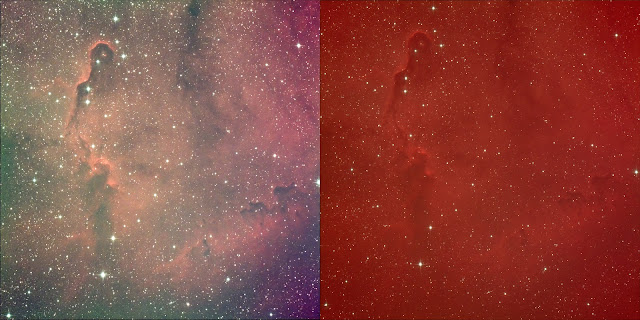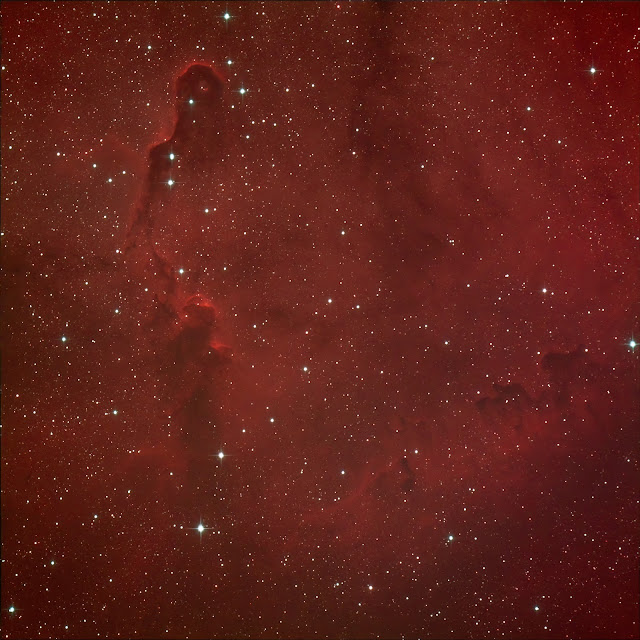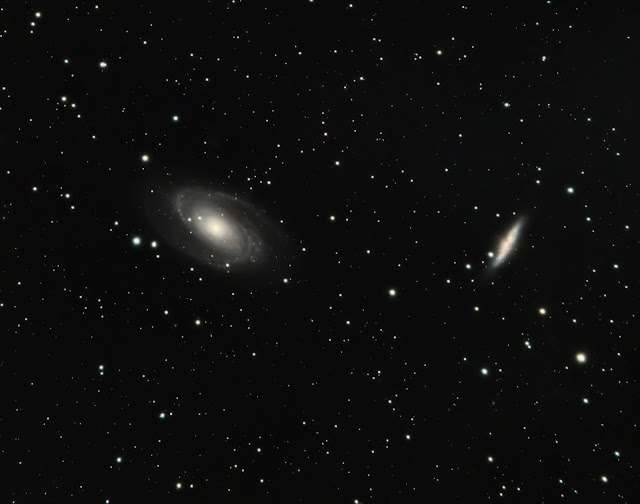Introduction
So, I thought I'd do a test to see results with the ZWO 533MC Pro camera using different gains on the same object. The goal was to see what the
Signal to Noise (SNR) would look like comparing unity gain (100 for the 533) versus gain 200. Unity gain for this camera is 100.
The test was on the Elephant Trunk nebula using an
Optolong L-Enhance filter. The L-Enhance is a duo band filter letting in Ha, Hb/Oiii.
The telescope I used is an f/4 Newtonian.
Objective
Test to see how much SNR degrades or improves when using a higher gain with the ASI533MC Pro.
Data Used
Sensor Temperature: -10 C
Ambient Temperature: 16.5 C
Dark Frames: 30
Bias Frames: 50
Flat Frames: None
Light Frames: (26) four minute exposures
Gain: 100 or 200
Processing Steps
For processing I used the same steps in both Deep Sky Stacker and Photoshop.
DSS Methods:
- Stacking Mode: Standard
- Drizzle: 3x
- Cosmetic: Remove hot and cold pixels
- Calibration: Per channel
- Light Frame alignment method: Kappa-Sigma, 5 iterations
Photoshop Processing Steps:
1. Set image to 16 bit mode
2. Adjust Levels: RGB dark level to the left of the histogram spike
3. Adjust Levels: Green dark to the left of the histogram spike
4. Adjust Levels: Blue to the left of the histogram spike
5. Adjust Curves: using standard preset dropdown: Lighter (repeated 10 times )
6. Adjust Levels: RGB dark level to the right of the histogram spike
7. Camera Raw Filter: Auto
8. Camera Raw Filter: Split Toning - Shadows to 20
9. Camera Raw Filter: Split Toning - Highlights to 20
10. Adjust Levels to 0, 1, 221
11. Topaz Noise AI - Auto detect settings; Low Light Mode to On; Color Noise reduction to 0.25
12. Set image size to 2000 x 2000
13. Save a JPG
Direct Results
Here is a side by side comparison of the two gains with the same processing applied. Personally I think they both are beautiful in their own ways. The gain 100 photo has more detail but far less nebulosity. To be fair, the gain 200 photo is hardly a final product while the gain 100 is closer to final.
One other note, is for the gain 200 process, I'd modify step 5 above to not be 10 steps.
Full sized images:
SNR Comparison before applying Topaz Noise AI:
So there are three conclusions that I take from comparing the images before noise reduction is applied.
1. The SNR 'seems' to be worse in the unity gain photo. I say seems because gain 200 brings in more nebulosity and might be hiding noise.
2. A proper SNR test would be on a galaxy or non-emission nebula object.
3. Using Topaz Noise AI renders the noise comparison irrelevant! This really is a marvelous product. You can try it free for 30 days.
Adjusting the Gain 200 Photo
Of course the comparison photo of the gain 200 photo was over-processed but was necessary for a one to one comparison. The image below represents something more like a finished product.
Conclusion
When it comes to photographing emission nebula with the ZWO ASI533MC Pro while using the Optolong L-Enhance filter, gain 200 is better than unity gain. I'll likely be sticking with gain 200 going forward on emission nebula but need to do another similar test on a bright galaxy or a bright reflection nebula. Maybe M45 would be a good target to test on using my Optolong L-Pro filter. What else could I do under Bortle 7 skies but use a LP filter?

























